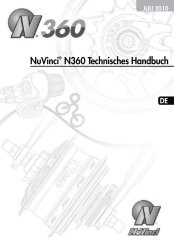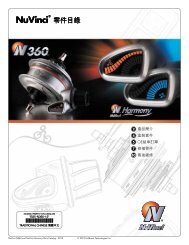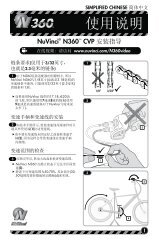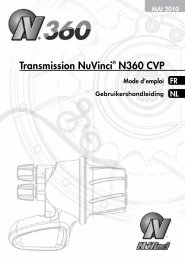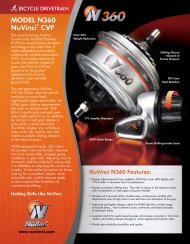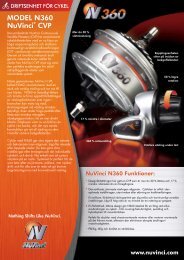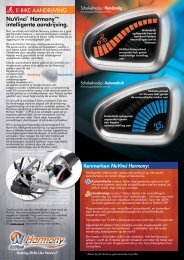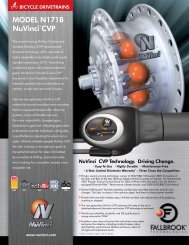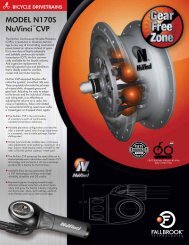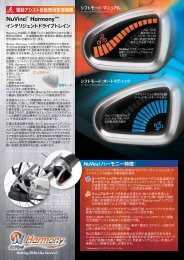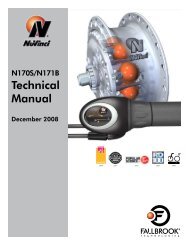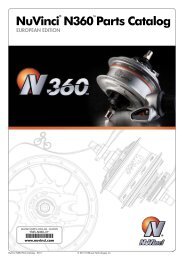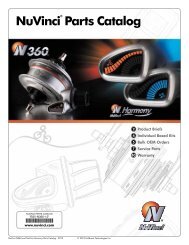Press Kit - Fallbrook Technologies Inc.
Press Kit - Fallbrook Technologies Inc.
Press Kit - Fallbrook Technologies Inc.
Create successful ePaper yourself
Turn your PDF publications into a flip-book with our unique Google optimized e-Paper software.
NuVinci ® – Powering Electric Vehicles<br />
Today’s electric vehicles (EVs), for the most part, do not use multi-speed transmissions. That<br />
means every time a driver starts from rest, climbs a hill or carries a heavy load in an EV, they’re<br />
reducing the amount of energy that they can get out of the batteries because in driving<br />
conditions like these, high flow rates of electrical current are required from the battery, which<br />
causes the battery charge to run down faster. Simple logic dictates that someone might want to<br />
do something to reduce the amount of time that the EV powertrain spends drawing a lot of<br />
amps so that they could maximize what they get to use versus what you put into the battery –<br />
something that could get them up to speed faster, or reduce the amps required to climb a hill,<br />
for example.<br />
EV’s traditionally have not used multi-speed, “clutch and gear” transmissions for a number of<br />
reasons, chiefly among them:<br />
<br />
<br />
<br />
Conventional multi-speed transmissions do not work well with electric powertrains<br />
because the abrupt steps between gears cause problems with durability and driving<br />
comfort.<br />
Conventional transmissions suffer from gear noise, which when an internal combustion<br />
(IC) engine is present, is drowned out by the engine noise. That background soundtrack<br />
is not present in an EV. Smaller, lighter, and more optimized vehicles cannot hide the<br />
excessive noise like a larger vehicle with an IC engine can.<br />
EV designers were driven by high electronics and battery costs to minimize the cost of<br />
the rest of the powertrain, and an electric motor’s inherent high torque at zero speed<br />
allows the design crutch of eliminating the transmission, at the expense of higher amp<br />
draws and a single compromised overall final gear ratio.<br />
The present single speed transmission forces the designer of the EV to select a much<br />
bigger VFD (Variable Frequency Drive) because of the higher current requirement.<br />
Consequently the cabling must be adequate in size to handle the larger VFD’s output<br />
(the larger wire size is heavier, more expensive, and harder to package because it does<br />
not bend as readily as smaller cables do). With a continuously variable accessory drive<br />
[J1] a smaller motor-controller system with lighter harness can produce the same<br />
performance of the single speed transmission that uses a larger motor-controller.<br />
This is where <strong>Fallbrook</strong> <strong>Technologies</strong> comes in with its NuVinci continuously variable planetary<br />
(CVP) system. The technology solves the issues of abrupt steps by smoothly and continuously<br />
varying speed ratio while also operating very quietly and, at the same time, increasing torque<br />
multiplication at low speed.<br />
<br />
<br />
The NuVinci CVP’s ability to change torque multiplication on the fly provides the<br />
following advantages to the EV designer:<br />
Amp draw in a start from rest is reduced in both amplitude and duration because the<br />
extra torque available from the motor/CVT combination accelerates the vehicle faster<br />
FT 080911 <strong>Fallbrook</strong> <strong>Technologies</strong> <strong>Inc</strong>. Electric Vehicle Applications Page 15



